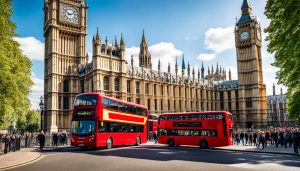Welcome to London, a city where history and modern life blend smoothly. This place is the heart of the UK. Any travel guide will say it’s full of famous landmarks. To really see its beauty, you must walk its ancient streets. You might love the old look of the Houses of Parliament or the creative vibe of the Southbank. London’s rich culture will catch your eye everywhere.
Stroll through small lanes that spread out from London’s historic spots. It’s like stepping back in time, through moments of victory and struggle. Every old stone has a story, ready to show you what London is about. Through this guide, we encourage you to uncover London’s secrets. Dive deep into your journey in this amazing city.
Discovering London: A City Steeped in History
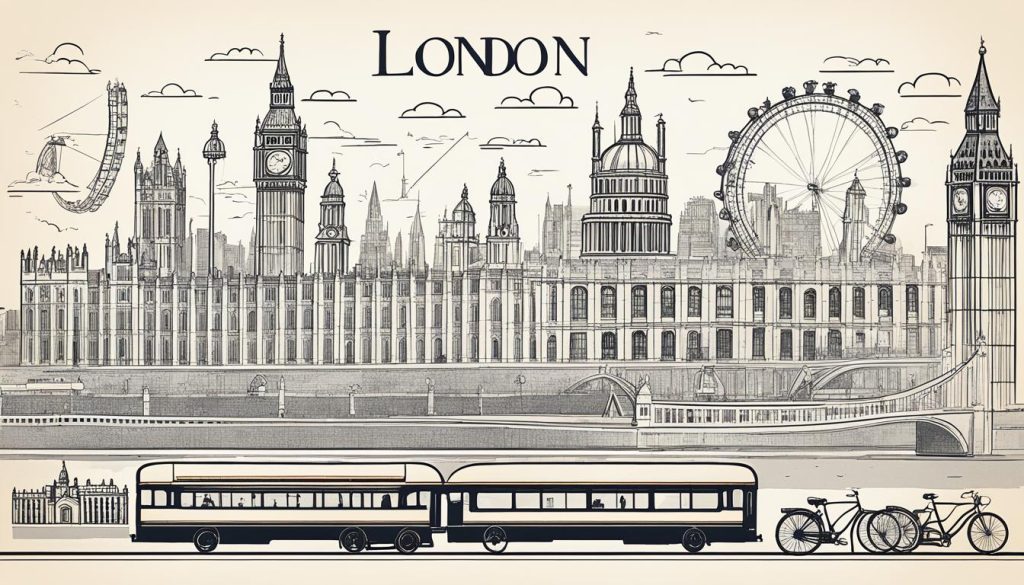
London’s history is a rich story that spans many ages. It starts from its ancient roots to its current global influence. We explore different eras, from Roman Londinium to the grand Tudor period. Each era has left its mark on this great city.
The Roman Foundations: Londinium Emerges
London’s journey began with Roman Londinium, founded around 47 AD. This first settlement laid the foundation for a future giant. Even today, we can see ancient relics that remind us of its Roman past. These ancient walls tell us about London’s long history.
Medieval Majesty: From Norman Conquest to Tudor Triumph
After Londinium, came the Medieval era. This period was full of knights, conquests, and the plague. Between the Norman Conquest and the start of the Tudor era, London grew. It became a center for trade and politics.
The Capital of an Empire: London’s Global Influence
From its medieval roots, London grew into the heart of an empire. The Tudor period was a time of art, architecture, and exploration. This era helped London become a city of global importance. It became the capital of an empire, influencing the world.
We see London transform from Roman to Tudor times. It has always changed, yet kept its unique identity. London became a global center not by chance, but through hard work. Its history is built on resilience, strategic growth, and cultural mix.
Geographical Tapestry: London’s Lay of the Land
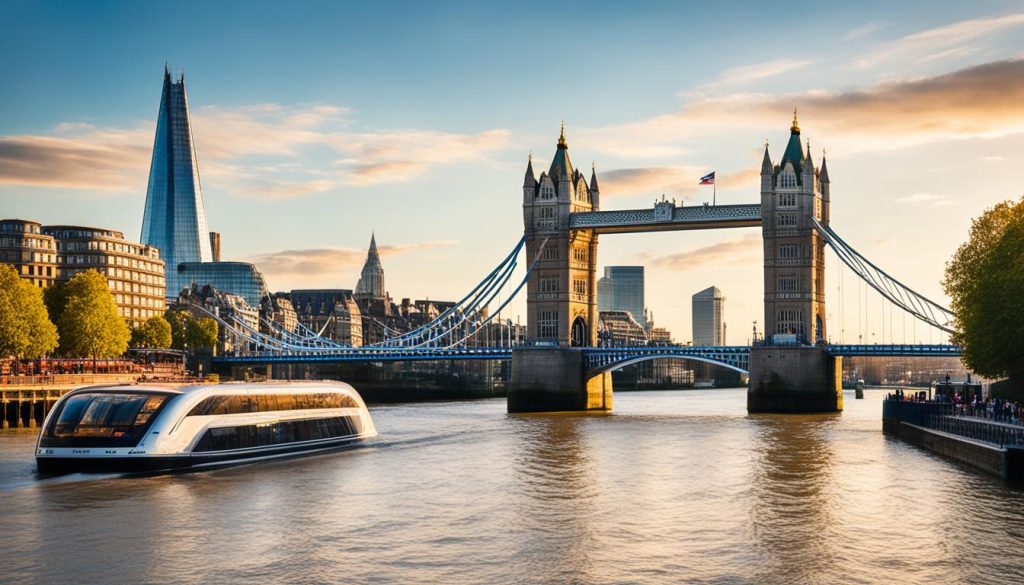
London stands out due to its location along the winding River Thames. This river is the heart of the city, shaping its geography and culture. Close to the busy quaysides, London opens up to beautiful parks and green areas. These spots offer a calm break from city life.
Spanning the Thames: London’s Iconic Waterway
The River Thames is key to London’s layout, cutting through the city. It brings history and daily life together. This river also divides areas and links the city’s parts. Historic and modern buildings along it show London’s growth over time.
A Green Metropolis: Exploring London’s Parks and Open Spaces
Around the city, there are many lush places and green spots. London loves its parks, like Hyde Park and Regents Park. These areas make the city more livable and show its love for nature. London is one of the greenest capitals.
- Hyde Park: A Royal Legacy and Community Haven
- The Regent’s Park: A Tapestry of Flowerbeds and Zoological Wonders
- Richmond Park: London’s Wilderness and Deer Sanctuary
- Hampstead Heath: Elevated Views and Swimming Ponds
Modern Governance: Steering London into the Future
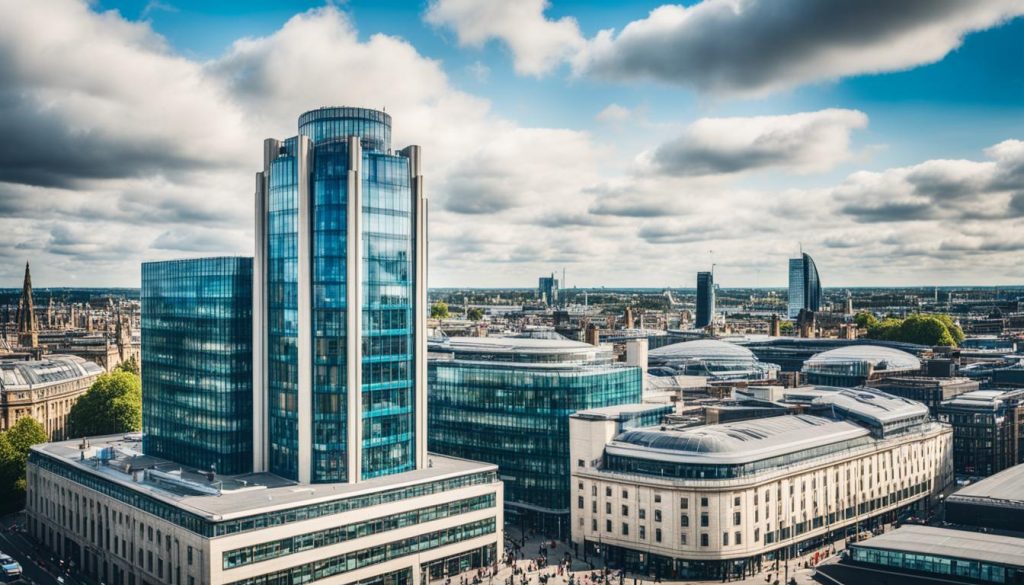
The Greater London Authority (GLA) is at the core of London’s local government. It plays a key role in making sure the city functions smoothly. Started at the turn of the millennium, the GLA brings together the Mayor’s Office and the London Assembly. This modern approach helps manage the metropolis effectively.
The Mayor of London, Sadiq Khan, leads with forward-thinking plans. He tackles today’s issues head-on, aiming for a vibrant future for London. His efforts are towards building a strong, flexible governance system for the city.
- GLA’s Strategic Reach – This body manages a group of 33 local authorities, including the historic City of London and 32 boroughs. Each contributes uniquely to London’s governance, adding to the city’s rich narrative.
- Collaborative Efforts – The GLA works on bringing local governments together. It promotes inclusivity, sustainability, and economic growth across London.
- Forward-Thinking Development – The London Assembly oversees planning and funding with an eye on innovation, social welfare, and better infrastructure.
The Greater London Authority strengthens London’s position, making it a hub of opportunity and a symbol of effective governance. The GLA ensures every part of London plays its role well, keeping the city globally competitive and forward-looking.
The Cultural Mosaic: London’s Diverse Communities
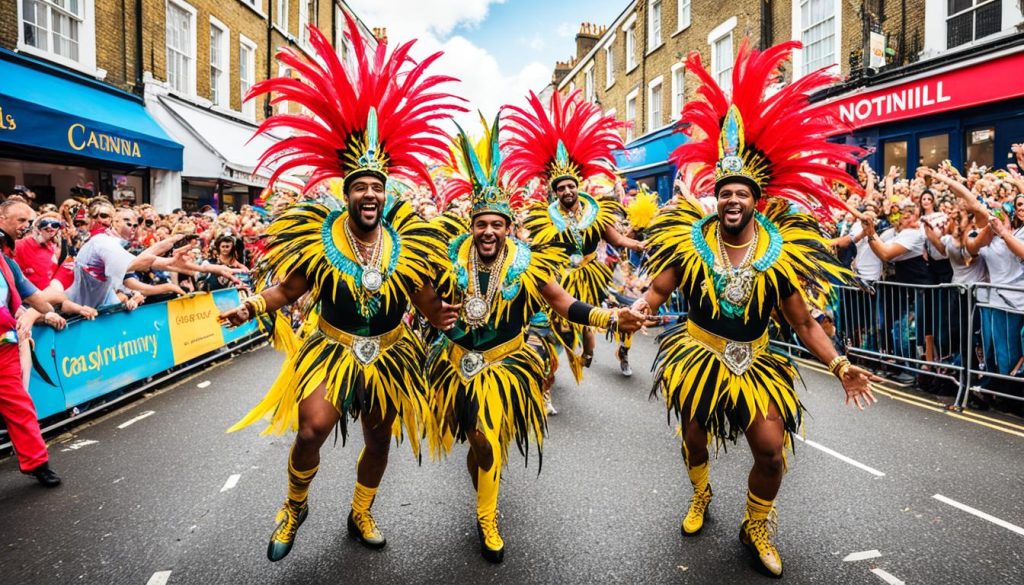
London is a city celebrated for its diversity. It is known for being welcoming to all. The city is a blend of many languages and traditions, making it unique.
Global Languages and Local Dialects
In London, over 300 languages fill the air. Every market and school is a place of cultural exchange. These languages help people connect, no matter where they’re from.
Festivals and Celebrations: A City of Joy
- The Notting Hill Carnival is a blast of colour, showing Caribbean culture at its best.
- For Lunar New Year, Chinatown shines with red lanterns and dragon dances, celebrating Chinese traditions.
- Diwali at Trafalgar Square brings light to London, showcasing the Hindu festival of lights.
These events offer a glimpse into London’s diverse cultures. They invite everyone to join in the joy that London’s festivals are famous for.
London’s Architectural Marvels: From Tower Bridge to The Shard
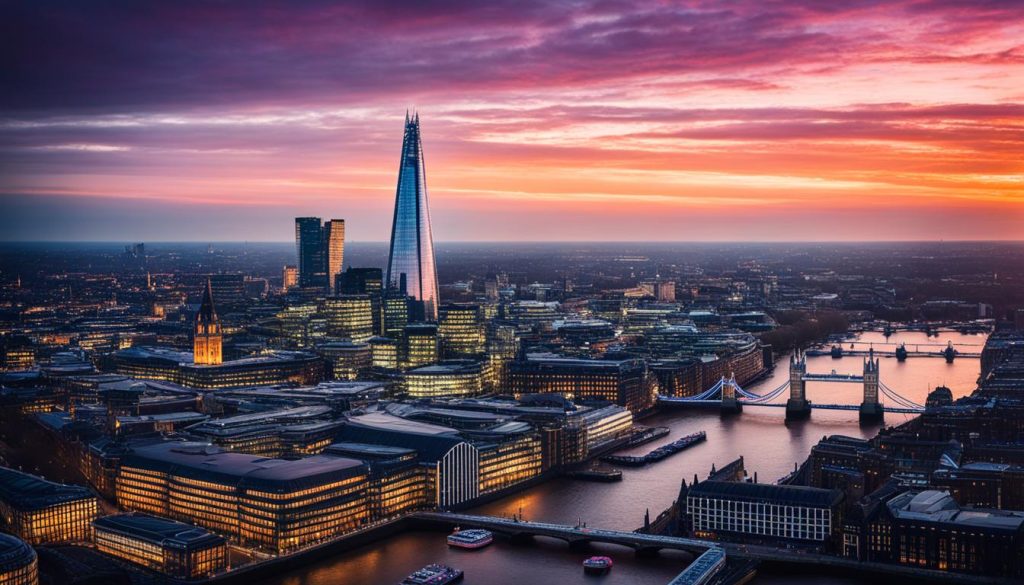
London’s architecture tells a story of its past and future. Historical charm and modern engineering mix in its landmarks. As you walk through London, you’ll be amazed by the architecture that shows different times and ideas.
Tower Bridge, under London’s skies, is a stunning sight. It’s more than a way to cross the River Thames. It shows Victorian genius and is a key piece of London’s architecture.
The Shard shoots up into the sky with its glass design. It shows London’s modern side, always moving forward. This building is not just the tallest; it’s a symbol of what London stands for today.
- Tower Bridge: Architectural Symbol of London’s Industrial Might
- The Shard: Representing the Zenith of 21st-Century London Architecture
These landmarks highlight London’s journey through time. They show its growth and the beauty of its architecture.
The London Scene: Arts, Theatre and Entertainment
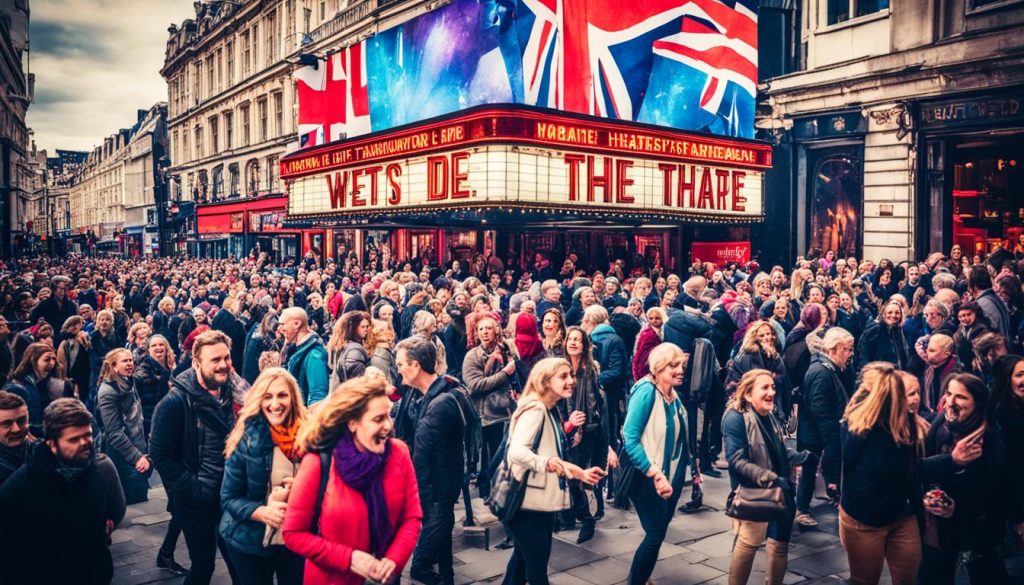
London’s entertainment is vibrant, full of the arts, amazing West End theatres, and galleries. These places draw people from everywhere who love art.
West End Magic: The Allure of London’s Theatres
The West End draws in those who love theatre. You find drama, comedy, and musicals there. Historic sites like the Royal Opera House add charm.
The place buzzes with life. Every night, people come to see the shows and the stars.
- The Lion King at the Lyceum Theatre
- Les Misérables at the Sondheim Theatre
- Hamilton at the Victoria Palace Theatre
- Phantom of the Opera at Her Majesty’s Theatre
A Hub for Art Lovers: Galleries and Museums Galore
London is perfect for those who love art. It has top-notch galleries and museums. The Tate Modern and British Museum are just the beginning.
- Tate Modern’s innovative exhibitions
- National Gallery’s classical collections
- Victoria and Albert Museum’s design and fashion displays
- Natural History Museum’s awe-inspiring natural wonders
Exploring London’s culture is more than just looking. It’s about getting into the spirit of creativity and global diversity. London is truly a cultural giant.
Explore London: Delving into the City’s Attractions
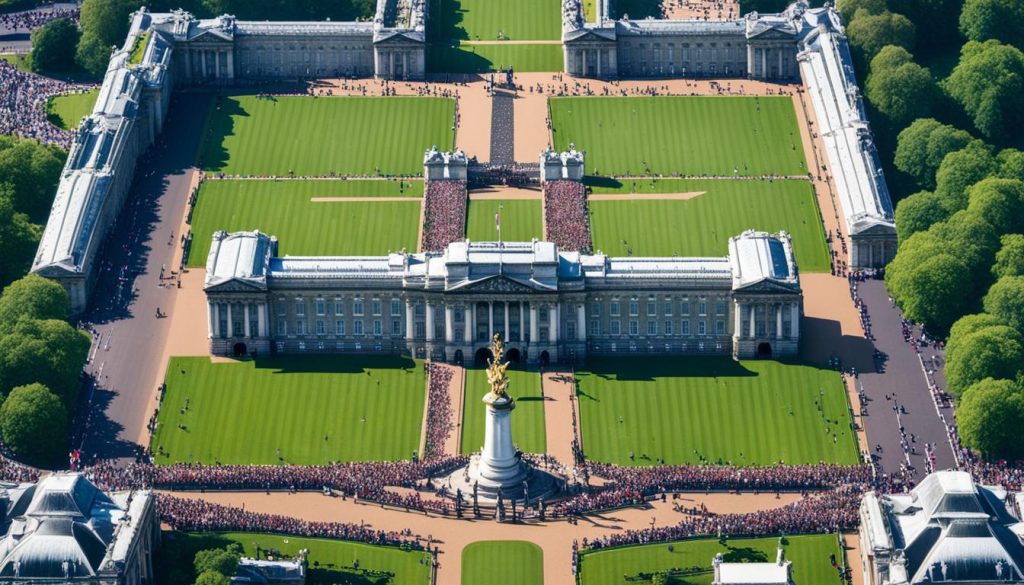
London invites you to explore its heart and soul. This journey reveals its rich history and modern life. You’ll find royal palaces and historic castles that highlight London’s royal past.
Royal Residences: Palaces and Castles
Experience royal splendour at palaces like Buckingham Palace and Kensington Palace. They have been homes to British monarchs for years. Don’t miss the Tower of London, a World Heritage Site. These places offer a peek into royal traditions, making them top stops for those interested in royalty and history.
The Charm of London Markets: Shopping and Sampling Local Delights
London’s markets turn shopping into an adventure. Find unique finds at Camden Market, antique treasures at Portobello Road, or gourmet foods at Borough Market. Each market buzzes with life, showcasing London’s diversity. You’ll experience new smells, sounds, and tastes around every corner.
From the grandeur of royal residences and castles to the lively atmosphere of markets, London’s charms beckon. These attractions offer a window into London’s vibrant culture, inviting everyone to discover and explore.
Educational Excellence: London’s World-renowned Institutions
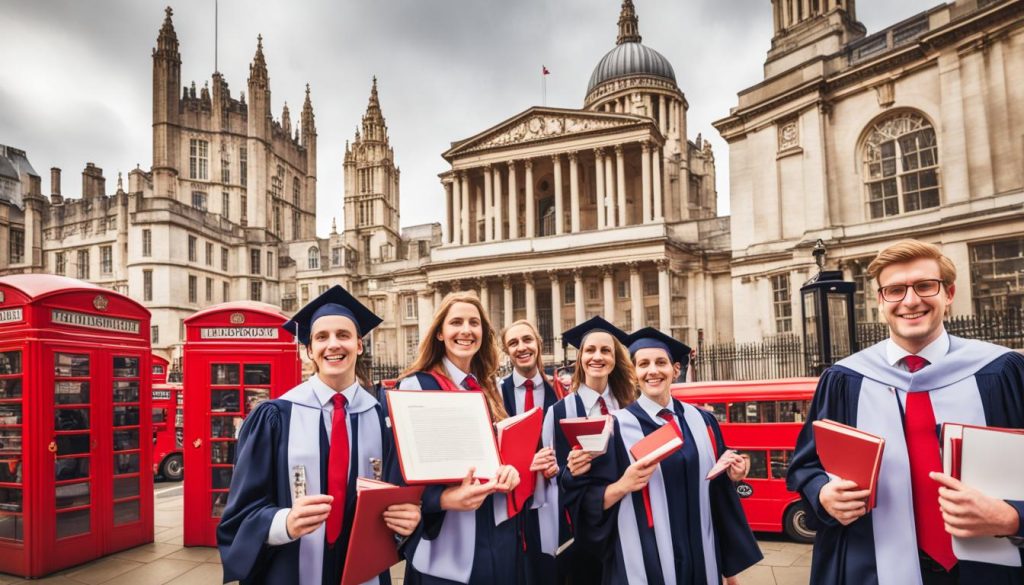
London stands out globally for its London education. The city draws attention not just for its history and culture, but also for its academic institutions. Academic excellence in London attracts ambitious students from around the world.
Top names like Imperial College London and London School of Economics are key. They’re known for their research and teaching quality. This makes London a top choice for education globally.
- Imperial College excels in science and technology, making big discoveries and advancements.
- The London School of Economics is renowned for its insights into social sciences and policy.
London’s universities are more than just places to study. They inspire questions and discoveries. They also create a vibrant community for sharing ideas and scholarship. London education is known for fostering groundbreaking ideas.
Students from all over come to London for more than studies. They’re also attracted by the city’s culture and job opportunities. Academic excellence in London connects closely with diverse industries. This helps students move smoothly into their careers. London offers a unique environment for personal and professional growth.
A Sporting Capital: London’s Legacy of Competition
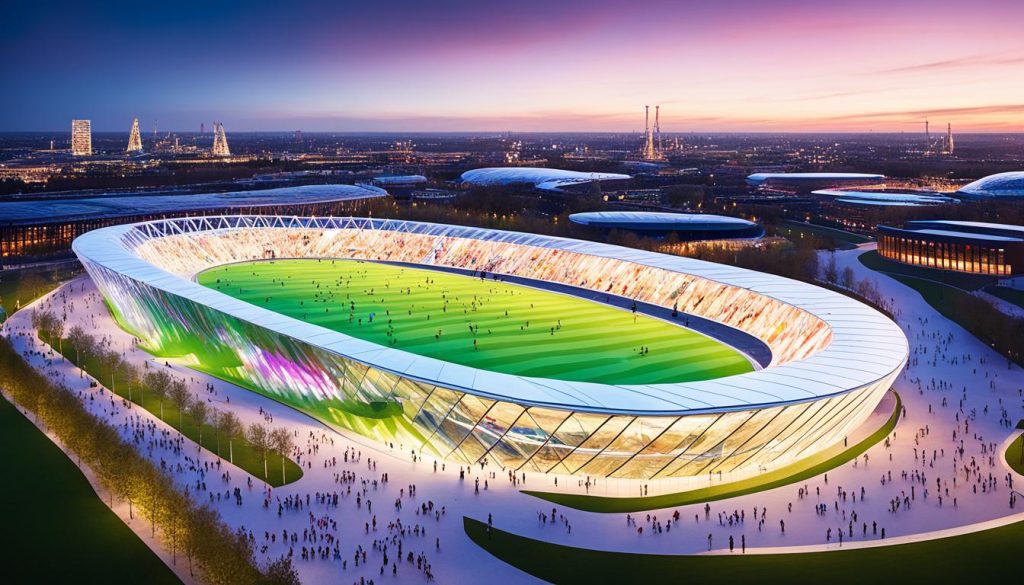
London is a hub for sports lovers, offering a rich sports legacy. The city is home to famous venues and events linked with sports history. One key highlight is the Wimbledon Championships, known worldwide in tennis.
The FA Cup Final, held at Wembley Stadium, adds to London’s sports prestige. This event is a big part of British sports culture. It creates an electric atmosphere, showing London’s love for football.
The 2012 London Olympics boosted the city’s status as a sports capital. It was a big event that brought the city together. It celebrated athletic skill and international friendship, leaving a lasting legacy that benefits the city.
- FA Cup – A Celebration of Football Heritage
- Wimbledon – The Allure of the Grand Slam
- London Marathon – Running Through History
- London Olympics – A Triumphant Host Thrice Over
- Sports Legacy London – Catalysing Urban Renewal
The London Marathon is another key event, showing endurance and community. Events like these boost London’s sports legacy and its spirit.
The Queen Elizabeth Olympic Park is a sign of the Olympics’ lasting effects. It’s a top facility for athletes and a community health spot. It shows London’s ongoing passion for sports, blending history with new goals.
London’s Transportation Web: Navigating the Metropolis
The streets and alleys of London are alive and bustling. Efficient transport is key to the city’s rhythm. London’s transport is more than just moving people around. It’s a vast network that shows London’s lively heart.
Underground Phenomenon: The London Tube
The London Underground is central to getting around. It’s the oldest rapid transit system in the world. It connects neighbourhoods and landmarks, making travel fast and comfortable.
- The Tube’s unique map and roundel show London’s blend of old and new.
- Each Tube line has its own story, like the deep blue Piccadilly or the bright red Central line.
- The thoughtfully planned routes are crucial for daily life, taking people to work and key spots.
From Buses to Bicycles: Surface Level Travel
Above ground, London’s transport turns colourful with its famous red buses. These buses link boroughs and suburbs, making the city accessible to everyone.
- Cycling in London is getting popular with special lanes and bike hire schemes. It appeals to those who love the environment and staying fit.
- Biking adds a green touch to transport, showing London’s push for sustainability and healthy living.
- Getting around London is easy, whether by bus, bike, or Tube. This ease shows a city designed for everyone’s movement.
The London Underground and buses and bikes together create a rich tapestry. They move people and link them closely with the city’s spirit.
Financial Hub: The Economic Pulse of London
London sits at the core of the UK’s strong economy, thanks to its lively financial sector. It hosts the well-known London Stock Exchange, making the city crucial for economic deals. London attracts investors worldwide, showing strength even after Brexit and staying a key European financial leader.
London’s financial power also adds a lot to the UK’s wealth. In 2021, its Gross Value Added (GVA) was £487 billion. This huge number proves London’s importance in finance. The city is not just for big companies but also helps new businesses grow.
- Strategic Financial Policies
- Innovative Financial Products and Services
- Dynamic Workforce in the Financial District
London’s finance world is both traditional and modern. It mixes its historical roots with today’s digital finance trends. This combination, seen in its old buildings and new towers, keeps London leading in global finance.
Gastronomic Adventures: London’s Culinary Scene
Start a journey through London gastronomy, a bright highlight of the city’s wide-ranging gourmet experiences. It shows London’s role as a hub for different tastes, from upscale dining to casual bites. The dining scene in London satisfies both food enthusiasts and casual eaters.
Michelin Starred Dining to Street Food
In London’s skies of culinary wonders, its Michelin starred restaurants shine the brightest. These places offer top-notch food, made by famous chefs from around the world. On the other hand, London’s street food scene is just as exciting. Markets all over the city offer delicious foods from around the globe. They make gourmet dining accessible to everyone.
Pubs and Tearooms: The British Experience
British pubs are key to understanding London’s social life. Not only do they serve beer, but also comfort food that Londoners love. Meanwhile, London tearooms are perfect for those seeking a British tradition. They offer afternoon tea with tasty sandwiches, scones, and various teas.
London’s food scene is always changing and growing, bringing new tastes to explore. Just come hungry to discover what London’s eateries have to offer. You’ll always find something new and exciting.
Annual Events: London’s Calendar Highlights
In the busy life of the city, London events bring a mix of experiences that show off the city’s lively side. Each event in the cultural calendar London has its unique feel, drawing in locals and visitors from around the world. They represent the unity and joy of celebration found in London.
London festival highlights fill the year with old and new celebrations. They let everyone enjoy the city’s culture. The New Year’s Day Parade starts the year with music, dance, and performances. It delights people of all ages.
- The Chelsea Flower Show starts in spring with beautiful flowers and garden designs.
- In summer, the Notting Hill Carnival is full of calypso music and Caribbean culture.
- The BFI London Film Festival in autumn celebrates movies from around the world.
- Winter Wonderland in Hyde Park makes the end of the year magical with holiday joy.
These annual celebrations London are key to bringing people together. They’re more than just fun times; they’re a part of London’s heart. They offer connection, happiness, and a shared experience that stands out from everyday life. London’s cultural scene is vibrant, making it a top place for arts, creativity, and togetherness.
Conclusion
As we conclude our exploration of London, we have experienced the historical, governmental, and cultural textures of the UK’s capital. London has shown us its remarkable depth through the eyes of travellers and lovers of the city. We’ve journeyed from ancient Roman times to the height of modern life.
London presents itself as a concerto of civilization, a mix of global voices. We’ve explored historic sites, dined finely, and enjoyed the West End’s sounds. The city’s top educational places and thrilling sports have also been highlighted. London’s transport system shows the city’s ongoing vibrancy.
Our journey shows that visiting London is more than sightseeing; it’s a deep dive into its legacy and future. As we end our story, we’re inspired to start our own adventures. In London, every arrival begins a unique story, part of a timeless, distinctly British tapestry.
